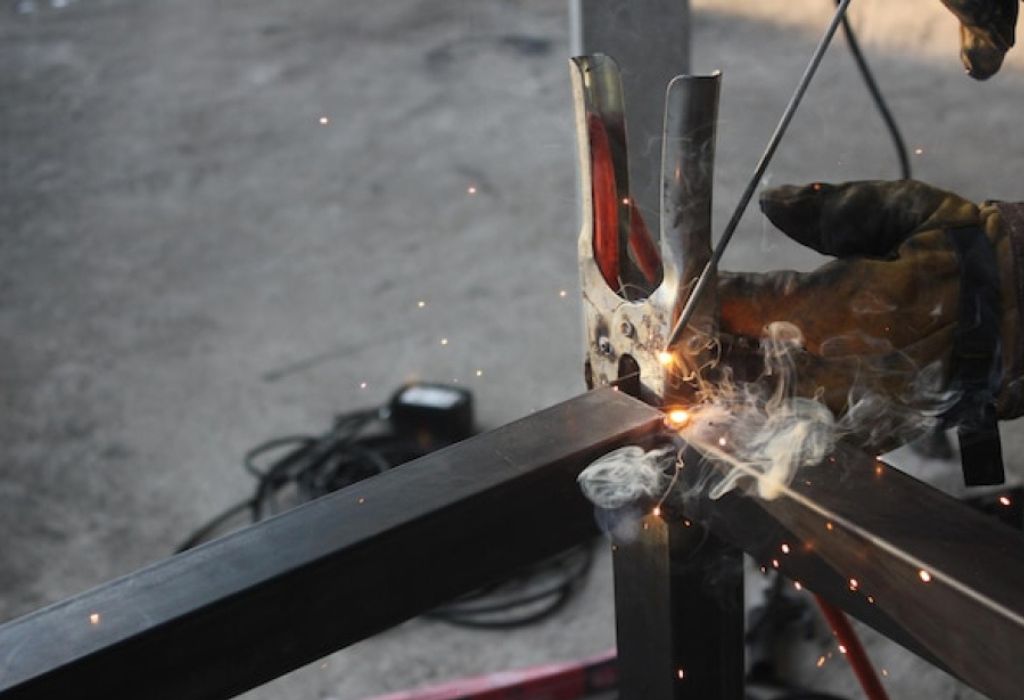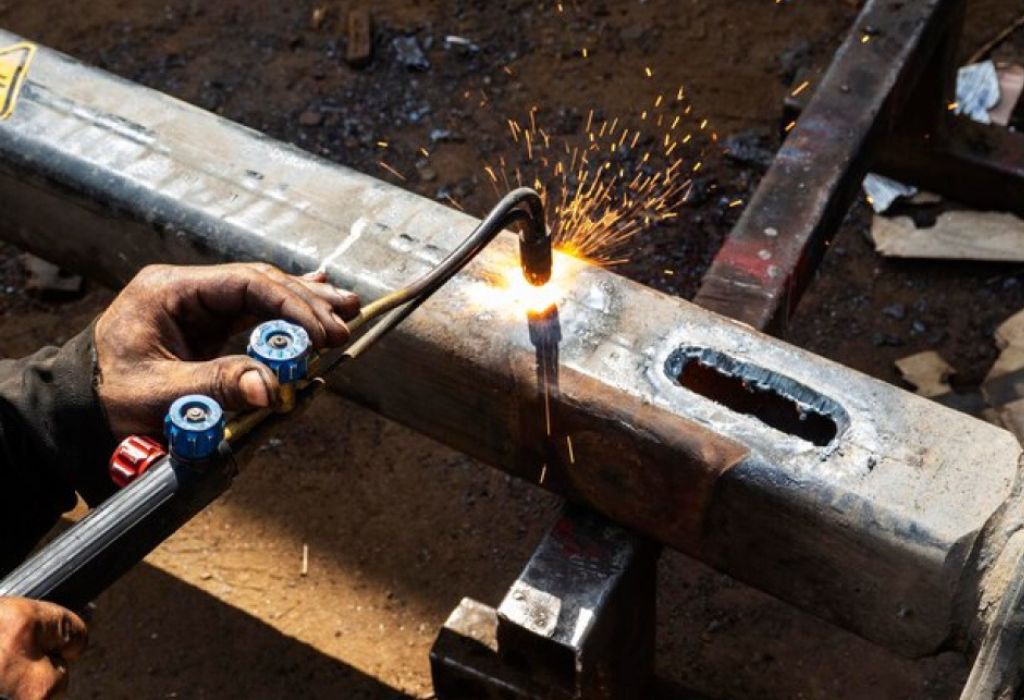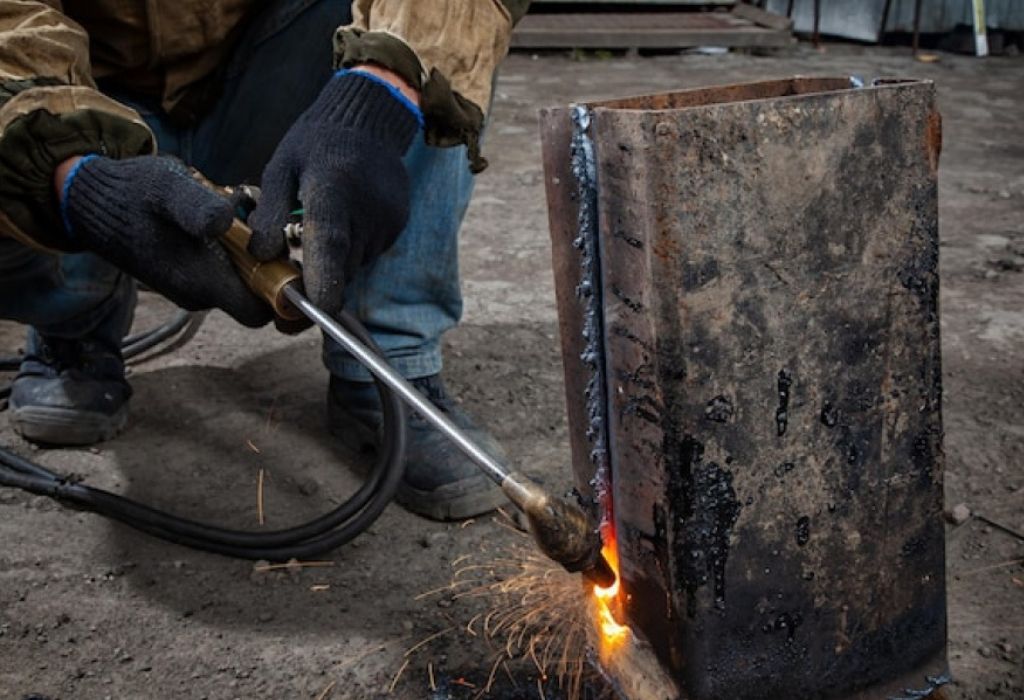Welding on cast iron can be one of the most intimidating tasks in metalworking. Many DIYers and even experienced welders have seen repairs crack hours or days after cooling, leaving them frustrated and out of options.
The truth is, cast iron behaves differently from steel. Its high carbon content and brittle nature mean one wrong step — too much heat, poor filler choice, or fast cooling — can destroy a casting beyond repair.
Did you know? Over 70% of failed cast-iron repairs happen due to improper heat control (AWS Research). But with the right process, patience, and filler selection, even cracked manifolds, gear housings, or machine bases can be restored safely.
This guide breaks down how to weld on cast iron step by step — from identifying the metal type to choosing between hot and cold welding, using the right nickel rod, and mastering cooling and peening techniques.
What Makes Cast Iron Hard to Weld

Cast iron contains a high percentage of carbon, usually between 2–4%, forming graphite flakes or nodules in its structure. When heated unevenly, those flakes expand differently from the surrounding metal, leading to cracks as the weld cools.
Another problem lies in the heat-affected zone (HAZ) — it becomes brittle because carbon migrates into the molten weld, creating hard spots that can’t absorb stress.
Why does cast iron crack after welding?
Because thermal stress builds up faster than the brittle metal can handle.
Is cast iron weldable at all?
Yes — with careful temperature control and the correct filler, you can make strong repairs.
What’s the safest way to weld it?
Use low-heat techniques or controlled preheating depending on the casting size.
Can I MIG weld it like mild steel?
Only if you use nickel wire and manage heat properly — otherwise, it will crack.
Why does porosity happen?
Oil or paint contamination releases gas bubbles as the metal melts.
Identify the Type of Cast Iron
Not all cast irons are created equal. The five main types — gray, ductile, malleable, white, and alloyed — behave differently under heat. Gray and ductile are the most weldable, while white iron is nearly impossible to repair without cracking.
How to Identify It
Look at the fracture surface. Gray iron shows a dull, grainy gray look, while ductile iron appears smoother with small round nodules. Perform a simple spark test — gray iron produces short, reddish sparks, while steel sparks are longer and more yellow.
Which type is easiest to weld?
Gray iron is common and welds well with nickel electrodes.
Can white iron be welded?
Not effectively — it’s too hard and brittle.
Do I need lab testing?
Usually no, simple spark and file tests are enough.
What if it’s oil-soaked?
Bake or heat it gently to remove oil before welding.
Does thickness matter?
Yes — thicker castings require slower, more even heating and cooling.
Choosing the Right Welding Process and Filler
The most common processes for cast iron are Stick (SMAW), TIG, MIG, and brazing. Each offers unique benefits depending on your project and budget.
Stick Welding (SMAW)
Use nickel electrodes like ENi-CI (pure nickel) for machinability or ENiFe-CI (nickel-iron) for strength.
TIG and MIG
TIG allows precision with nickel rods, while MIG with nickel wire can cover larger areas faster — but heat input must stay low.
Brazing
This low-temperature method bonds cast iron using bronze filler and flux, avoiding fusion and minimizing cracking risk.
Which rod should I use?
ENiFe-CI rods are ideal for general repairs.
When should I choose pure nickel?
If you need a smooth, machinable finish.
Is brazing strong enough?
Yes — perfect for non-structural or leak repairs.
Do stainless rods work?
Sometimes, but they create very hard deposits that are tough to machine.
Can I mix welding and brazing?
Only with clear separation — never on the same joint.
Preheating vs Cold Welding
The two main approaches to welding cast iron are hot welding (with preheat) and cold welding (without preheat). The difference lies in how the metal expands and contracts during welding.
Preheating keeps the entire casting warm, reducing stress between hot and cold zones. Cold welding uses short, controlled stitches with cooling breaks to minimize heat input.
Do I always need preheat?
Not necessarily — small parts can be cold welded.
How hot is “preheated”?
Typically between 500°F and 1200°F (260°C–650°C) depending on thickness.
What is interpass temperature?
It’s the temperature you maintain between weld beads to avoid rapid cooling.
Why peen each bead?
Peening counteracts shrinkage stress before the bead hardens.
How should I cool it afterward?
Slowly — cover with sand, vermiculite, or an insulating blanket overnight.
Surface Preparation and Joint Design
Cleanliness determines success. Remove oil, rust, and paint using a grinder or degreaser. Drill small stop holes at the ends of cracks to prevent further spreading. Bevel the crack into a V-groove for deeper penetration.
A clean, shiny metal surface helps nickel filler fuse properly.
Why drill stop holes?
They relieve stress and stop crack propagation.
What bevel angle is best?
Around 60° for complete fusion.
Should I bake old castings first?
Yes — it burns off oil trapped in the pores.
Do I need back-gouging?
Only for full-penetration repairs.
Is flux required for brazing?
Always — it prevents oxidation and improves bonding.
Step-by-Step: Cold Welding Technique

Cold welding is the most common method for small castings or when preheat isn’t practical.
- Grind and clean the crack area.
- Tack weld both ends.
- Run very short beads (no more than 1 inch).
- Stop after each bead to allow complete cooling.
- Peen lightly while the weld is still warm.
- Continue the pattern until filled.
How long should each bead be?
One inch or less.
Can I stack passes quickly?
No — let each pass cool completely.
What tool should I peen with?
A small ball-peen hammer works best.
When should I grind the surface?
After full cooling, never while hot.
Why do some cold welds still crack?
Because the part cooled too fast or wasn’t clean.
Step-by-Step: Hot Welding Technique
Hot welding is used for larger, heavier castings where uniform heat can be maintained.
- Heat the entire casting evenly to the target preheat temperature.
- Weld using nickel-iron rod and moderate heat.
- Peen after each pass to relieve tension.
- Maintain temperature during the process.
- Cool very slowly in dry sand or insulation.
Why heat the whole casting?
Uniform expansion prevents new cracks.
Can I use a torch for preheating?
Yes, but move continuously to avoid hotspots.
What if some areas cool faster?
Wrap them with insulation or heating blankets.
Can I mix hot and cold methods?
No — use one consistent approach.
How do I check temperature?
Use temperature crayons or an infrared thermometer.
Brazing for Cast Iron Repairs
Brazing uses a bronze filler to join cast iron without melting the base metal. It’s ideal for thin sections, leaks, and low-stress components.
Apply flux, heat gradually, and feed the filler so it flows into the joint. Avoid overheating — the bronze should melt, not the base iron.
Does brazing change metal structure?
No, it stays below the melting point of cast iron.
Is the joint strong?
Yes, but not as strong as fusion welding — use for moderate loads.
Can I braze exhaust manifolds?
Absolutely — it’s often the safest repair method.
Will it be machinable afterward?
Yes, bronze is easy to cut and polish.
What’s the right flux?
A commercial bronze brazing flux rated for cast iron.
Peening, Cooling, and Stress Control
Peening relieves stress while the weld metal is still ductile. Tap lightly in circular motions after each bead to flatten and stretch the weld slightly. Cooling should be gradual — the slower, the better.
Rapid cooling causes internal tension, which leads to cracking even hours later.
Should I peen TIG welds too?
Yes, use light tapping before they harden.
What if cracks reappear?
Drill small holes at both ends and re-weld with better heat control.
Is post-heating needed after cold welds?
Not required; focus on slow cooling instead.
Can I bury the part in sand overnight?
Yes — that ensures even temperature drop.
Why avoid water cooling?
It creates brittle, glass-hard spots.
Post-Weld Finishing and Inspection
After cooling to room temperature, grind the weld flush with the surface. Use dye-penetrant testing to spot surface cracks and pressure testing for leak repairs.
Machine the surface only if the filler rod supports it — pure nickel deposits are best for machining.
When can I machine the weld?
Only when completely cool.
What if the surface is too hard?
Use carbide tooling or switch to a machinable filler next time.
How to ensure leak-tightness?
Perform a pressure test or submerge test.
Is stress relief always needed?
Not usually — proper cooling does the job.
How to prevent future cracks?
Avoid overheating the part during service.
Common Welding Defects on Cast Iron
Typical problems include porosity, lack of fusion, cracking, and hard spots. Most come from contamination or poor heat control.
Why did pores form?
Because oil or moisture escaped during welding.
What causes lack of fusion?
Dirty metal or insufficient amperage.
How do I fix a small leak?
Use a short repair bead or bronze patch.
Why did it crack overnight?
Cooling too quickly or unevenly.
Can a cracked weld be re-repaired?
Yes — grind out the crack and repeat with slower cooling.
Safety and Maintenance

Welding cast iron produces fumes and sparks that need proper PPE and ventilation. Always remove nearby flammables, wear gloves, goggles, and a face shield.
Work in a well-ventilated area, especially when brazing with flux.
Is cast-iron fume dangerous?
Yes, prolonged exposure can cause metal fume fever.
Should I use a respirator?
Always when working indoors.
Do I need a fire blanket?
Yes, preheating can easily ignite nearby materials.
What lens shade is best?
Shade 10–12 for stick or TIG welding.
How to handle hot castings?
Use tongs and insulated gloves — they hold heat longer than steel.
Cost and When to Replace Instead
Sometimes, repair isn’t the smartest option. If cracks extend through multiple areas or the casting is oil-soaked beyond cleaning, replacement may be cheaper.
Still, proper welding saves countless dollars on rare or discontinued parts.
Is nickel rod expensive?
Yes, but failed repairs cost far more.
When should I replace the part?
If it’s white iron, fractured severely, or under high pressure.
Is brazing cheaper?
Usually, and it needs less power or setup.
Do repairs void warranties?
They might — always check manufacturer policies.
When should I consult a professional?
For structural, pressure-rated, or safety-critical components.
Latest Trends and Pro Tips
Modern welding blankets and digital preheaters make temperature control easier than ever. Induction heating systems ensure uniform warmth without flame contact.
Use temperature crayons to check surface heat before each pass, and try new low-fume nickel electrodes for cleaner, safer work.
Are induction preheaters worth it?
Yes — they provide precise, even heating.
Do temperature crayons really help?
Absolutely, they give instant feedback.
Any new filler materials?
Nickel-iron blends with better machinability are now common.
Is laser repair viable?
In industrial settings, yes, for small cracks.
Where can I learn more?
Check AWS.org and TWI Global.
Conclusion
Welding cast iron isn’t impossible — it just demands control, patience, and the right technique. Identify your iron type, pick the correct nickel rod, clean thoroughly, and decide between hot or cold welding based on part size.
Remember to peen every bead, cool slowly, and never rush the process. Following these principles ensures every weld holds firm, whether you’re fixing an exhaust manifold or restoring an antique engine block.
Master these techniques, and you’ll know exactly how to weld on cast iron the right way — safely, cleanly, and with confidence.

I’m Darrell Julian, the founder, lead writer, and hands-on welding enthusiast behind ArcWeldingPro.com. With more than 15 years of real-world welding experience, I created this platform to share what I’ve learned in the field, in the shop, and in the heat of the arc.


